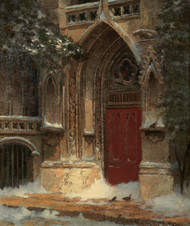Edwin Deakin
Published by Therese Myles on 29th Oct 2019
Edwin Deakin became famous as an American landscape painter. He was born in Sheffield, England on May 21, 1838 and developed an early interest in ancient castles, old churches and romantic ruins. Edwin received his only art training as an apprentice to a company that specialized in the technique of japanning. From the age of 12 he learned to paint small landscape pictures onto furniture and wooden boxes.
Deakin had established himself as an architectural artist by the time he was 18 and made the move to Chicago in 1856 where he started to support himself by painting memorials to heroes of the Civil War. He and his wife left Chicago in 1869 to move west and Deakin lived for the rest of his life in Berkeley, California.
When he had set up his studio in San Francisco, Deakin was accepted as a member of the San Francisco Art Association. His paintings were exhibited at their shows and at also at Mechanics Institute Fairs.
His life interest in historic buildings led Deakin to explore the old Spanish missions in California. These had originally been set up by Franciscan fathers and played a significant part in the early history of the state. Deakin began to study the remains of these buildings and their history. He often visited them in remote areas, where he produced a great many sketches and architectural drawings. Back in his San Francisco studio Deakin used what he had discovered to created a series of 21 paintings.
The unique attributes of the early California mission buildings are fully revealed in the intensity of the paintings that Deakin created from his sketches. He appreciated the restful atmosphere of the mission buildings, their dignity and sense of order.
Deakin created these paintings because he wanted people to understand the importance of Spanish missions to the early settlers in California. He was also able to highlight the romantic quality of the subsequent decay of the buildings and to bring the beauty of their peaceful rustic settings to a wider audience. He gained an international reputation when two of his mission paintings were displayed in a Paris salon.
Most of Deakin’s delicate watercolor studies of historic California missions were part of a project that he was never to complete. He painted them with the idea of producing an illustrated book, but this was never published. Russell placed his precious watercolor paintings carefully inside a cloth bag that was sewn up to protect them from the light. Some 70 years after they were painted, the mission pictures, still sealed inside their black bag, were rediscovered at a facility where they had been put into storage.
Deakin also visited Wyoming, Utah and Colorado and many of his landscape paintings were based on the sketches he made there in the mountains, canyons and rural communities. In addition to producing a number of notable landscape paintings, Edwin Deakin also used oil paints for his still life subjects. He continued to work successfully as an artist until his death on May 11, 1923.

